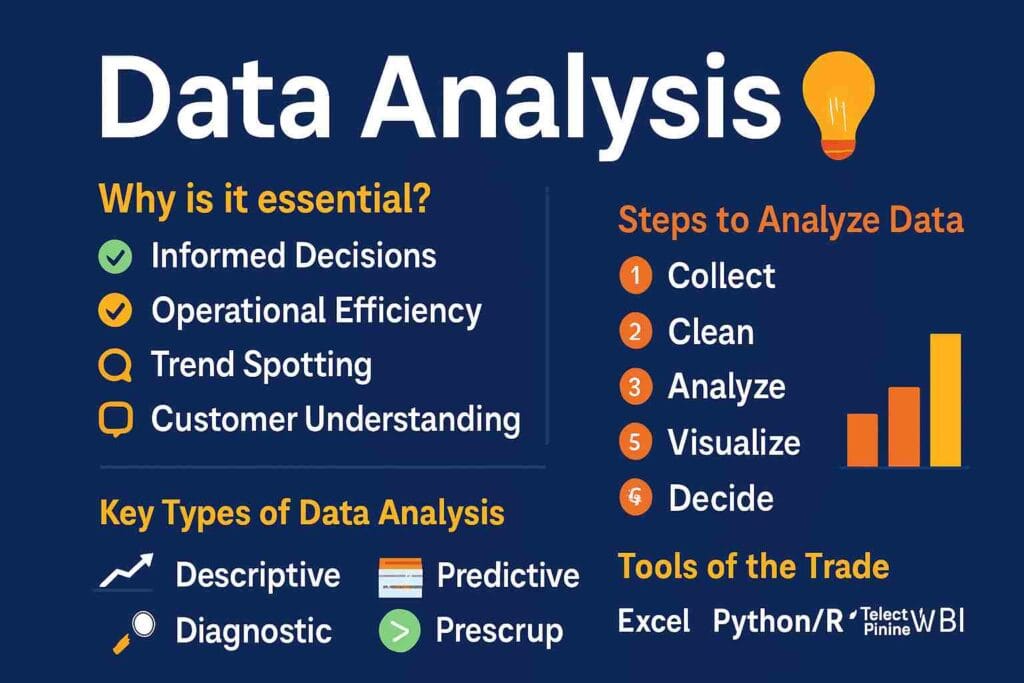Data Analysis: A Comprehensive Overview

Data analysis is a crucial process in transforming raw data into meaningful insights that can guide decision-making. It is the backbone of any data-driven organization or research endeavor. In this article, we will dive into the significance of data analysis, the various methods used, and how businesses and individuals can leverage it to optimize their operations.
What is Data Analysis?
Data analysis refers to the process of inspecting, cleaning, transforming, and modeling data to discover useful information, draw conclusions, and support decision-making. It involves a series of techniques that help uncover patterns, correlations, and trends from datasets, ultimately leading to actionable insights.
The Importance of Data Analysis
In the digital age, data has become one of the most valuable assets for any organization. Businesses collect massive amounts of data every day, whether it’s about customer behavior, operational performance, or market trends. Data analysis helps to:
- Make Informed Decisions: By analyzing data, organizations can make decisions based on facts and evidence rather than assumptions or intuition.
- Improve Operational Efficiency: Analyzing operational data can highlight inefficiencies, allowing companies to optimize processes and resources.
- Identify Trends and Patterns: Data analysis helps identify emerging trends and patterns, enabling businesses to stay ahead of the competition.
- Measure Performance: Data analysis allows businesses to track key performance indicators (KPIs) and measure success over time.
- Enhance Customer Insights: Analyzing customer data helps businesses understand customer needs, preferences, and behaviors, leading to improved products and services.
Types of Data Analysis
Data analysis can be broadly categorized into several types based on the methodology and purpose:
- Descriptive Analysis: This method focuses on summarizing historical data to describe past events. Common tools include averages, percentages, and visualizations like bar charts and pie charts.
- Diagnostic Analysis: This type of analysis seeks to identify the causes behind certain outcomes. It often involves comparing different datasets to uncover the factors contributing to specific trends or issues.
- Predictive Analysis: Predictive analysis uses historical data to forecast future trends and behaviors. Machine learning algorithms and statistical models are often used to predict future outcomes.
- Prescriptive Analysis: This approach provides recommendations based on data analysis, helping organizations optimize decisions. It typically involves optimization techniques and simulations.
- Exploratory Analysis: This type is more open-ended, aiming to uncover hidden patterns or insights from data without a predefined hypothesis. It’s useful when you want to explore new data or look for unexpected trends.
The Data Analysis Process
The process of data analysis generally follows a series of steps to ensure the accuracy and usefulness of the results:
- Data Collection: This step involves gathering relevant data from various sources. This can include surveys, databases, or external data sources such as social media or market research reports.
- Data Cleaning: Raw data often contains errors or inconsistencies. Cleaning data involves removing duplicates, fixing errors, and handling missing values to ensure the data is accurate and reliable.
- Data Transformation: In this step, the cleaned data is transformed into a format suitable for analysis. This might include normalizing data, encoding categorical variables, or aggregating data at different levels.
- Data Analysis and Modeling: This is where the actual analysis occurs. Statistical and machine learning models are applied to the data to uncover trends, patterns, and insights.
- Interpretation and Visualization: After the analysis, results are interpreted and presented using charts, graphs, and tables. Data visualization tools like Tableau, Power BI, and Matplotlib help make the findings more understandable and actionable.
- Decision Making: The final step involves using the insights gained from the data analysis to make informed decisions. These decisions can range from improving a product to making strategic business changes.
Tools and Technologies in Data Analysis
Data analysis relies heavily on a wide range of tools and technologies. Some of the most popular tools include:
- Excel: Excel is one of the most common tools used for data analysis, especially for smaller datasets. It offers various built-in functions for summarizing and analyzing data.
- R: R is a programming language and software environment for statistical computing and graphics. It is widely used by statisticians and data scientists for data analysis.
- Python: Python, with libraries like Pandas, NumPy, and SciPy, is one of the most versatile programming languages for data analysis and machine learning.
- SQL: SQL is used for managing and querying relational databases. It helps analysts extract and manipulate large datasets.
- Tableau and Power BI: These tools are popular for creating interactive visualizations and dashboards, allowing for data exploration and reporting.
- Hadoop and Spark: For large-scale data processing, Apache Hadoop and Apache Spark are commonly used, especially for big data analysis.
Applications of Data Analysis
Data analysis is applied across various industries and sectors, including:
- Healthcare: Data analysis helps in patient diagnosis, treatment planning, and operational efficiency improvements.
- Finance: In finance, data analysis is used for risk management, fraud detection, and investment strategies.
- Retail: Retailers use data analysis for customer segmentation, inventory management, and sales forecasting.
- Marketing: Data-driven marketing campaigns are based on analyzing customer behavior, preferences, and engagement.
- Education: Schools and universities use data analysis to improve learning outcomes, optimize course offerings, and track student performance.
Challenges in Data Analysis
Despite its importance, data analysis comes with several challenges:
- Data Quality Issues: Inaccurate, incomplete, or inconsistent data can lead to misleading results.
- Data Overload: With the explosion of data, extracting useful insights from vast datasets can be overwhelming.
- Data Privacy Concerns: Collecting and analyzing personal data raises concerns about privacy and security.
- Skill Gaps: Data analysis requires specialized skills, including proficiency in programming, statistical analysis, and data visualization, which can be a barrier for many organizations.
Conclusion
Data analysis is a critical tool for modern decision-making across all sectors. By applying the right techniques and tools, organizations can gain valuable insights from their data, optimize operations, and create new opportunities. As data continues to grow in volume and complexity, the importance of data analysis will only increase, making it a vital skill for the future.
Source : Medium.com




